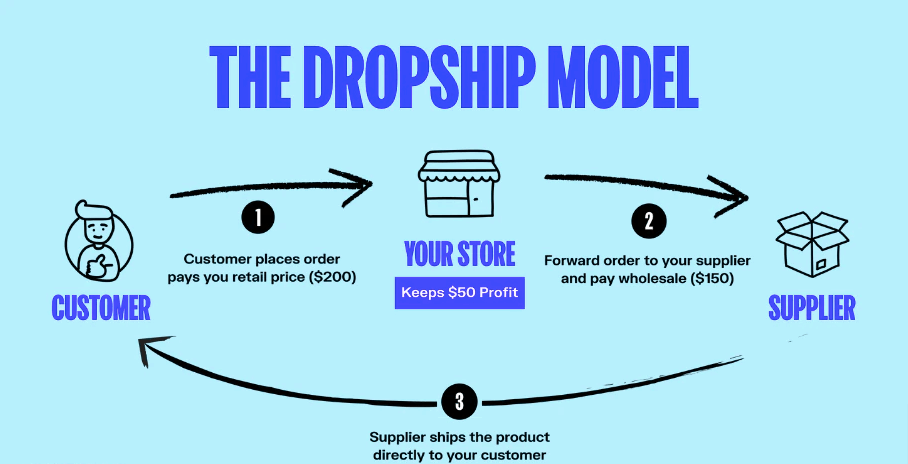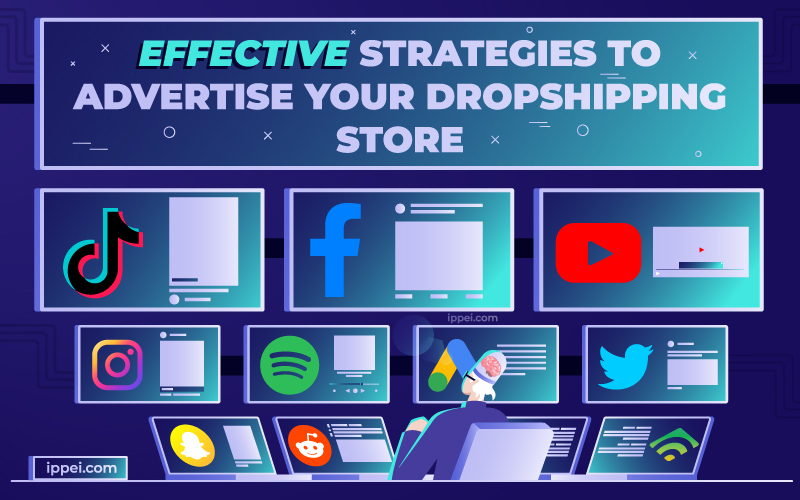Digital dropshipping has emerged as a popular e-commerce business model, allowing entrepreneurs to sell products without physically handling or storing inventory. In this blog post, we’ll explore the fundamentals of dropshipping, its pros and cons, and whether it’s a viable option for your business.
What is dropshipping?
Dropshipping is an e-commerce business model where the retailer (you) doesn’t keep products in stock. Instead, when a customer places an order on your online store, you purchase the product from a third-party supplier or manufacturer, who then ships the product directly to the customer’s address. As the retailer, you never handle or store the physical products yourself.
How does dropshipping work?
- Setting up an online store: You create an ecommerce website or use an existing platform like Shopify to list products from various suppliers.
- Customer places an order: A customer visits your online store, browses through the products, and makes a purchase.
- Forwarding the order: You forward the order details and customer shipping information to appropriate supplier.
- Supplier ships the product: The supplier processes the order, packages the product, and ships it directly to the customer’s address.
- Customer receives the product: The customer receives the product as if it were shipped from your own inventory.

Pros and cons of dropshipping
Benefits
Low overhead costs
One of the primary advantages of dropshipping is the low overhead costs involved. Since you don’t need to purchase and store inventory upfront, you eliminate the need for a physical storefront, warehouse space, or inventory management. This significantly reduces your initial investment and ongoing operational costs.
Wide product selection
With dropshipping, you can offer a vast array of products without the need to physically stock them. This allows you to test different product niches and quickly adapt to market trends without the risk of being stuck with unsold inventory.
Flexibility and scalability
Dropshipping businesses are highly scalable. As your sales grow, you can easily add more products or work with additional suppliers without the need for extra storage space or staff. This flexibility allows you to respond quickly to changes in demand or market conditions.
Location independence
Since you don’t need to manage physical inventory, you can run your dropshipping business from anywhere in the world, as long as you have an internet connection. This makes it an attractive option for those seeking a location-independent lifestyle or a side business.
Limitations
Low profit margins
One of the main drawbacks of dropshipping is the relatively low profit margins compared to traditional retail models. Since you’re essentially acting as a middleman between the supplier and the customer, your profit is the difference between the wholesale price you pay the supplier and the retail price you charge the customer.
Inventory and shipping issues
While you don’t handle the physical products, you’re still reliant on your suppliers for inventory availability and timely shipping. Delays, stock shortages, or shipping errors can negatively impact your customer experience and reputation.
Fierce competition
Dropshipping has a relatively low barrier to entry, which means there’s a lot of competition in popular product niches. This can make it challenging to stand out and attract customers, especially when competing with established dropshipping businesses and traditional retailers.
Limited branding opportunities
Since you don’t physically handle the products, it can be difficult to create a strong brand identity. Customers may associate the product more with the supplier or manufacturer than with your online store.
Is dropshipping right for your business?
Dropshipping can be a viable business model for those looking to start an e-commerce venture with minimal upfront investment and overhead costs. However, it’s essential to carefully evaluate the potential pros and cons to determine if it aligns with your business goals and resources.
Here are some factors to consider:
- Profit margins: Assess whether the potential profit margins from dropshipping are sufficient to sustain and grow your business. Consider the competition, pricing strategies, and potential for volume sales.
- Product sourcing: Research reliable and trustworthy suppliers that offer high-quality products, competitive pricing, and efficient shipping. Establish clear communication channels and agreements to ensure smooth operations.
- Marketing and branding: Develop a strong marketing strategy to differentiate your business and attract customers in a competitive market. Focus on building a recognizable brand and providing exceptional customer service.
- Legal and regulatory compliance: Familiarize yourself with relevant laws and regulations, such as product liability, consumer protection, and tax requirements, to ensure compliance and avoid potential legal issues.
- Time and commitment: While dropshipping requires less upfront investment than traditional retail, it still demands significant time and effort to research products, manage suppliers, market your business, and provide customer support.
Best ways to advertise your dropshipping store
Effective advertising and marketing are crucial for the success of your dropshipping business. Here are some of the best ways to promote your store and attract customers

Paid Ads
TikTok Ads
With its massive user base and highly engaging content, TikTok has become a popular platform for advertising, particularly for reaching younger audiences. TikTok ads can take various forms, such as In-Feed Videos, Brand Takeovers, and Branded Effects, allowing you to create engaging and shareable content that showcases your products.
Facebook Ads
Facebook remains one of the most powerful advertising platforms, offering granular targeting options and various ad formats, including image, video, carousel, and collection ads. By leveraging Facebook’s extensive user data and targeting capabilities, you can reach your ideal customers with tailored messaging and visuals.
Instagram Ads
As a visually-driven platform, Instagram is an excellent choice for promoting products and building brand awareness. Instagram ads seamlessly integrate with users’ feeds, allowing you to showcase your products in an engaging and visually appealing manner.
Google Ads
Google Ads, including Search and Shopping campaigns, can be highly effective for driving targeted traffic to your online store. With Search Ads, you can appear at the top of Google’s search results for relevant queries, while Shopping Ads showcase your products with images, prices, and promotional text.
Other Marketing Methods
- Influencer marketing: Collaborate with influencers in your niche to promote your products and tap into their engaged audience.
- Content marketing: Create valuable content, such as blog posts, videos, or podcasts, to establish your brand as an authority in your industry and attract potential customers.
- Email marketing: Build an email list and leverage email campaigns to nurture relationships with existing customers, promote new products, and offer exclusive deals or discounts.
- Social media marketing: Maintain an active presence on relevant social media platforms, engage with your audience, and leverage social media advertising tools to reach potential customers.
Conclusion
Dropshipping can be a profitable and flexible business model, allowing entrepreneurs to start an e-commerce venture with minimal upfront investment. However, it’s essential to understand the pros and cons, conduct thorough research, and develop a solid marketing strategy to stand out in a competitive market.
By leveraging paid advertising platforms like TikTok, Facebook, Instagram, and Google Ads, as well as other marketing methods like influencer marketing and content creation, you can effectively promote your dropshipping store and reach your target audience.
Ultimately, the success of your dropshipping business will depend on your ability to find reliable suppliers, offer quality products, provide exceptional customer service, and continuously adapt to market trends and customer demands.
